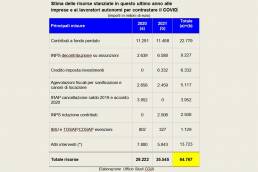PMI: still half of the anti-COVID aid to be disbursed in Italy
Of the 64.7 billion allocated by the Conte and Draghi governments to economic activities to cope with the crisis, 50 percent comes from the Budget Law 2021
Just under 50 percent of the anti-COVID aid earmarked for Italian small and medium-sized businesses has yet to be credited.
Even for the current year, a small part has arrived and will continue to arrive directly in the current accounts of companies.
A substantial part, in fact, will be allocated when companies activate some specific operations.
However, of the 64.7 billion euros of direct aid made available by the Conte and Draghi governments to businesses to deal with the COVID emergency, the CGIA Studies Office estimates that just under 50 percent has not yet been credited, as these are resources largely provided for in the Budget Law 2021.
This is supported by an analysis by CGIA Mestre published on April 24.

“Only” 22.8 billion in non-repayable resources
Even though these 64.7 billion euros constitute a very significant amount, only 22.8 billion euros are the resources disbursed on a non-repayable basis (equal to 35.2 percent of the total).
Moreover, if compared to the approximately 350 billion euros of contraction in turnover recorded by Italian companies in 2020, these 64.7 billion “cover” only 18.5 per cent of the total shortfall.
It is clear that the Draghi government must accelerate not only on the vaccination front, but also on the speed of delivery of measures to support micro-businesses and the self-employed.
The next Support Decree is a real test bench
The next Support Decree, in fact, will be an important test bench.
Not only because the economic dimension will have to be decidedly more substantial than the measures previously approved, but also because they will have to reach the current account of entrepreneurs very quickly.
We would like to remind you that of the 35.5 billion euros of aid provided for the current year, 6.5 billion euros will allow INPS decontribution for new hires and another 6.3 billion euros will be provided as tax credits for investments.

2.5 billion INPS decontribution to the self-employed
If we add the 2.5 billion INPS decontribution to VAT registered companies that lost more than a third of their turnover last year, these 15.3 billion euros (equal to 43% of the total aid for 2021) are unlikely to benefit micro enterprises and the self-employed, who have been hardest hit by the crisis.
First of all, because at this moment they certainly do not need to hire; secondly, because they certainly do not have the liquidity to activate new investments; thirdly, due to the absence of the Decree of the Ministry of Labour, which had to be approved by the beginning of March, they cannot yet benefit from the INPS contribution discount.

The problem is not the confinement measures
In other words, underlines the Association of Craftsmen and Small Businesses CGIA Mestre, the main Italian problem is not the closures imposed by decree by our Government, given that currently in all the other main European countries the confinement measures are more stringent than ours, but the economic aid, which in Italy has arrived to an insufficient extent and with serious delay.
Elsewhere, on the other hand, it has been provided promptly and on a very significant scale.
To save Italian micro and small enterprises means to safeguard an important part of our country’s economy.

SMEs employ 54.6 percent of the workforce
The numbers are eloquent. Net of civil servants, activities with fewer than 20 employees make up 98 percent of the companies in the country and employ the majority of Italians, i.e., 54.6 percent of the employed.
Moreover, these micro realities produce 37% of the annual national added value, a score not found in any other major country of the European Union.
With an economy based on very small enterprises, but with economic/employment performances like giants, the competitiveness of our country suffers above all from the absence of large enterprises.
For many decades, in fact, the latter have disappeared, certainly not because of the excessive number of small production realities present in Italy, but due to the inability of large players, mainly of a public nature, to withstand the challenge launched by globalization.
Italy leader until 1985 in technological sectors, but…
Until 1985, in fact, Italy was among the world leaders in chemistry, plastics, rubber, iron and steel, aluminum, information technology and pharmaceuticals.
Thanks to the role and weight of many large public and private companies (Montedison, Montefibre, Pirelli, Italsider, Alumix, Olivetti, Angelini, etc.), the country’s economy revolved around these sectors.
Over 35 years later, however, Italy has lost ground and leadership in almost all these sectors.
And this has happened not because of a cynical and baroque fate, but as a result of a selection process that has relegated them out of the market.
In the light of these specificities, the Study Office of the CGIA strongly asks that we return to look with greater attention to the world of the enterprises, in particular to the small and the micro, considering that, for example, the effects of the pandemic are falling with unheard-of violence above all on those of the tertiary and the services that, if not helped adequately, risk to close definitively.







